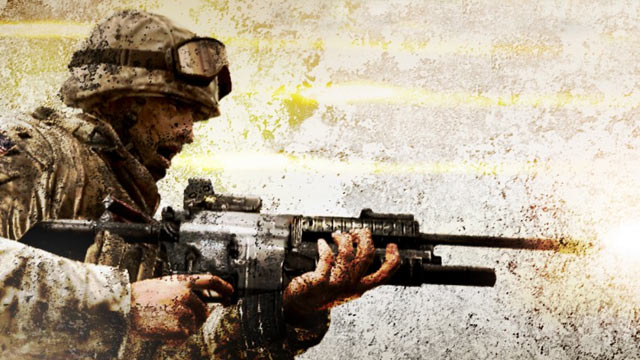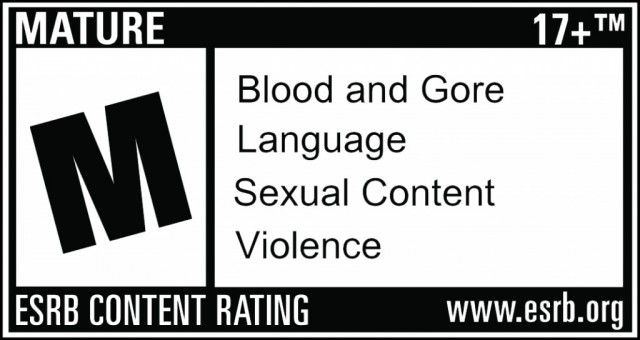
I was walking through a Toys R Us the other day when I noticed a Call of Duty: Ghosts jet black backpack in amongst the Angry Birds and Barbie ones. At first, I just assumed it was an honest mistake; Toys R Us does sell messenger bags and backpacks geared towards older kids, so it must have gotten accidentally moved to the wrong spot. When I reached out to grab the backpack and give it a look, however, I realized it was no mistake at all, as it was child-sized. Which made no sense. With a large ESRB M-rating on every cover of each yearly installment, Call of Duty is clearly labeled and known as a franchise for older teens and adults. Yet there I was, standing in a Toys R Us holding a Call of Duty: Ghosts backpack made for an eight year old.
Now, I’m not being naive and pretending that kids don’t play Call of Duty games. I’ve been the victim of ranting 4th graders while playing online more times than I’d care to admit, so I am well aware that grownups aren’t alone on Activision’s servers. Activision, apparently, knows this, too, and seems to have gotten the brilliant idea to begin selling toys and merchandise with Call of Duty branding specifically targeted at children. I snooped around the store a little further to confirm my theory and sure enough, along with the backpack, I also found sets of Call of Duty Mega Blocks. It was like finding a Django Unchained lunchbox stuffed in amongst the Toy Story and Cars ones. I was irritated, because as I stood there with the backpack in my hands, all I could think of is how self-destructive this move by Activision could be.

In 1992, Midway pushed the boundaries of blood and gore in a video game with the release of the fighting game Mortal Kombat. The game’s violent antics caught the attention of many gamers, but it wasn’t long before other people started noticing it, too, and for very different reasons. Parents and politicians were incensed, insisting that video games were the great corruptors of children and calling for the complete censorship of the industry. The outcry was so powerful that it ultimately resulted in the Entertainment Software Association establishing a new organization called the Entertainment Software Rating Board (ESRB) to evaluate and rate the content of all video games. It was a victory for the industry, as the ESRB would provide protection to both developers and consumers with these new ratings, allowing for continued creative freedom and helping buyers make more informed purchasing choices. At least, in theory.
On paper, the implementation of the ESRB and its rating system has been a success. According to the ESRB, “89% of parents are involved in the purchase or rental of a video game for their child”, while further noting that “87% of parents are aware of ESRB ratings.” Further bolstering these claims is a 2013 study by the Federal Trade Commission that found of all other entertainment industries, video games were the most successful at self-policing the distribution of its content, as only 13 percent of underage teenagers were able to purchase M-rated titles. Compare that to the 47 percent of kids who were able to purchase explicit content-labeled CDs and 24 percent who bought R-rated movie tickets. Impressive numbers, but they don’t communicate the entirety of the situation.
It was only two years ago that California’s proposed law to prevent the sale of M-rated games to minors was shot down by the Supreme Court. Following the Sandy Hook and Aurora mass shootings, Vice President Biden met with video game developers to discuss the issue of guns and violence in games. While the establishment of the ESRB did further assert the legitimacy of the industry, video games remain an easy scapegoat for society’s ills. People can ingest all the violence and sex they want from TV, books, and movies, but when it comes to video games, there remains a double-standard. The ESRB and FTC can claim that M-rated games are being kept out of the hands of kids, but that’s a disingenuous statement; the kids might not be buying those games, but they’re still playing them.

Unfortunately, anyone who has worked at a GameStop or the electronics department of a Walmart can attest to the extreme disregard that many parents show ESRB ratings. Though every game box is clearly labeled with a rating and corresponding description, droves of parents still buy titles like Grand Theft Auto 5 and Assassin’s Creed 3 for their prepubescent sons and daughters. For all the years of continued animus, many of the same parents who rally against the video game industry singlehandedly enable their children to play games they claim to hate. I’ve personally heard parents say they didn’t approve of the game they were buying their kid, but did it just to keep them quiet, or because their friends were going to be playing it. It’s a maddening situation, because no matter how much effort the industry makes to be responsible, it will be a futile gesture if parents don’t uphold their end of the deal.
The Call of Duty child’s backpack is an insult to every developer and publisher that has fought for video games to be respected. The industry can’t defend itself from unfair criticism when one of its most prominent developers blatantly uses predatory marketing gimmicks to target M-rated games at children. Activision, unfortunately, isn’t alone in this practice. Microsoft has also inundated the market with its own line of Halo Mega Blocks and Gears of War Erector Sets. People can argue that perhaps the real intended audience of these toys are collectors and not kids, but when the merchandise is wedged between Marvel Superhero LEGOs and Super Mario K’Nex, that stops being believable. Children will always be an integral part of the video game industry, and while their parents might not consistently execute the best judgment when buying them games, that doesn’t give developers carte blanche to underhandedly market their M-rated games at them. Advocates who struggle to communicate the incredible diversity and value of video games as a form of entertainment and art don’t need anyone undermining their efforts, least of all the the industry’s own developers.




 ShareThis
ShareThis






